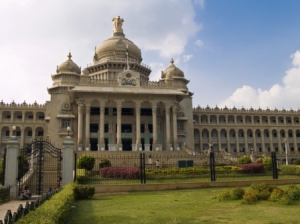BANGALORE/BENGALURU AND KARNATAKA
Direct flights from the UK into the city make this an ideal starting point to explore Karnataka. The city is situated nearly 1000m above sea level, giving it a very pleasant and cool climate leading it to be referred to as the garden city. There are numerous parks and gardens in this vibrant cosmopolitan city which feels quite different from many other Indian cities. There are trendy boutiques, glitzy malls, pubs, clubs and thanks to the largest foreign population in India a varied choice of foreign cuisine. It is a major business, science and technology centre but also retains links with its past. It flourished in the late 18th Century under the rule of Hyder Ali whose son was Tipu Sultan, a brilliant military tactician and great Indian nationalist hero who fought the British and earned the title the “ Tiger of Mysore. Bangalore’s growth has brought some problems; crazy traffic and frequent power cuts.
 Places of Interest
Places of Interest
VIDHANA SOUDHA
This is a beautiful building which is not open to the public. Impressive granite structure of Indo-Dravidian style built in mid 1950s.
LAL BAGH BOTANICAL GARDENS
A 240 acre park originally designed in 1760 by Hyder Ali and some of the trees date back to the days of his son Tipu Sultan. It has one of the largest collections of rare tropical plants. The best time to visit is October to December when most flowers are in full bloom. At the heart of the park is the Rose Garden with around 150 different varieties of roses.
BULL TEMPLE
This small temple houses an enormous monolith of Nandi, the sacred Hindu bull that carries Shiva. It is beautifully carved and glistens with peanut oil applied weekly by priests. It can be quite touristy and occasional hassle from opportunistic guides and priests offering pujas (blessings.) Down a flight of stairs is another 500 year old temple, the Gavi Gangadhareshwara Temple.
GAVI GANGADHARESHWARA TEMPLE
It has a circumambulatory passage which is so low you have to bend almost double. On the day of Makar Sankranti in January the sun’s rays pass from a side window through the horns of the Nandi facing the Shivling and fall directly on the lingam itself.
BANGALORE PALACE
It is not as grand or impressive as its Mysore neighbour but still worth a visit. Built around 1880 for the exorbitant cost of 1 million rupees it is said to have been inspired by a visit to Windsor Castle by the Maharaja of Mysore.
TIPU’S SUMMER PALACE
This is based on Tipu’s summer palace at Srirangapatnam, a river island near Mysore (which is in better condition.) It has 2 floors and is made largely from teak with walls and ceilings painted in brilliant colours and beautiful carvings. Only part of the original palace remains. A museum relates the history of the reign of Tipu and his Father and their struggle against the British.
BANGALORE WALKS
Organised nature and historical walks which run between 7am to 11am every Saturday and Sunday.
HAMPI
The world famous ruined City of Victory, Vijayanagar, better known as Hampi (the local village) lies 10 hours from Bangalore and is best reached by the overnight Hampi Express.
This UNESCO Heritage site was once the capital of three generations of Hindu rulers who reigned for more than 200 years. It was devastated by a six month siege by Muslims in the latter part of the 16th century. The city was looted and burned for months and the once mighty capital was left deserted and in ruins.
Today it is recommended to take a guide around to explain the ruins and the site is divided into two areas, one around Hampi Bazaar and the river where the most sacred temples and ghats are found including Virupaksha Temple. The second area is 2 miles south of the river and features the remains of palaces, elephant stables and pavilions in the Royal Enclosure.
Best time to visit is November to March before it gets too wet or hot. There is a lot of walking to do so keep well hydrated. Accommodation in the Bazaar is pretty basic but does allow easy access to the ruins especially if you want to watch the sunrise from the temple on top of Matanga Hill. The ruins rise up through the morning mist which, as it clears, reveals the boulder dotted landscape and meandering Tungabhadra River below.







